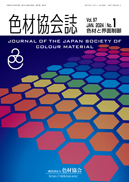
- Issue 4 Pages 94-
- Issue 3 Pages 69-
- Issue 2 Pages 39-
- Issue 1 Pages 2-
- |<
- <
- 1
- >
- >|
-
Yoshimune NONOMURA2024 Volume 97 Issue 3 Pages 69
Published: March 20, 2024
Released on J-STAGE: March 26, 2024
JOURNAL FREE ACCESSDownload PDF (199K)
-
Bungo OCHIAI2024 Volume 97 Issue 3 Pages 70-72
Published: March 20, 2024
Released on J-STAGE: March 26, 2024
JOURNAL RESTRICTED ACCESSThis review introduces a polymer synthesis comprising of concurrent radical polymerization and carbon dioxide fixation of glycidyl methacrylate (GMA). GMA is a reactive acrylic monomer, which is radically polymerized, and its epoxy ring is a stepping stone for functionalization. Polymers bearing five-membered cyclic carbonate moieties are produced by radical polymerization of GMA under a carbon dioxide atmosphere in the presence of radical initiators and carbonation catalysts such as alkaline metal halides. This system realized a reduction of energy cost and processes by the concomitant two reactions. Spherical particles can be obtained by appropriately tuning reaction conditions, especially solvents and additives.
View full abstractDownload PDF (877K) -
Kazunari YOSHIDA2024 Volume 97 Issue 3 Pages 73-76
Published: March 20, 2024
Released on J-STAGE: March 26, 2024
JOURNAL RESTRICTED ACCESSThe surfaces of transparent wings, such as those of dragonflies, possess the fine structures which have various functions such as anti-reflective properties. Similar fine structures also exist on the wings of green lacewing and are believed to have a diverse array of functionalities. However, only a few studies on the optical properties of green lacewing wings have been reported. Herein, I introduce the research on surface structure of green lacewing wings and its associated optical properties. Specifically, I focus on the results of transmittance measurements and findings derived from the Finite-Difference Time-Domain (FDTD) method. While the research presented in this paper was primarily driven by fundamental curiosity, I hope that it will make a meaningful contribution to the broader field of color materials research.
View full abstractDownload PDF (1450K) -
Yoshitaka KOSEKI, Hitoshi KASAI2024 Volume 97 Issue 3 Pages 77-80
Published: March 20, 2024
Released on J-STAGE: March 26, 2024
JOURNAL RESTRICTED ACCESSThe development of drug delivery systems (DDS) that allow therapeutic agents to accumulate and exert their effects only at the affected sites is particularly important for the development of drugs that cause severe side effects, such as anticancer drugs. In this review, using SN-38, an anticancer drug, as a model compound, we will discuss the establishment of a method for the preparation of single-molecule nanodrugs using the reprecipitation method, a method for the preparation of organic nanoparticles, the molecular design for controlling the drug release from the nanodrug, and research cases related to the evaluation of pharmacological activity by cell and animal experiments.
View full abstractDownload PDF (979K) -
Masanobu SAGISAKA2024 Volume 97 Issue 3 Pages 81-85
Published: March 20, 2024
Released on J-STAGE: March 26, 2024
JOURNAL RESTRICTED ACCESSTo generate a low surface energy, fluorinated surfactants were used in various fields of applications for long time. However, usage of those is now restricted due to their bioaccumulativeness and other potential risks to the human body and environment. This article introduces the molecular design, interfacial properties and applications of green low surface energy surfactants known as “hedgehog surfactants” which have the possibility to replace fluorinated surfactants.
View full abstractDownload PDF (1029K)
-
Jun KAWAKAMI2024 Volume 97 Issue 3 Pages 86-90
Published: March 20, 2024
Released on J-STAGE: March 26, 2024
JOURNAL RESTRICTED ACCESSHirosaki University, located in Aomori Prefecture, the northernmost prefecture in Honshu, Japan, began research on tryptanthrin extracted from indigo in 2000, and reported its high antibacterial activity against Malassezia furfur, a causative agent of atopic dermatitis, and its inhibitory effect against contact dermatitis. In the process of synthesizing several tryptanthrin derivatives as antibacterial agents, we accidentally discovered that 2-aminotryptanthrin, in which an amino group was introduced at the 2-position of tryptanthrin, exhibited strong fluorescence, and started new research on tryptanthrin derivatives as fluorescent dyes. Here, we describe the research on fluorescent tryptanthrin derivatives conducted at Hirosaki University.
View full abstractDownload PDF (2126K)
- |<
- <
- 1
- >
- >|